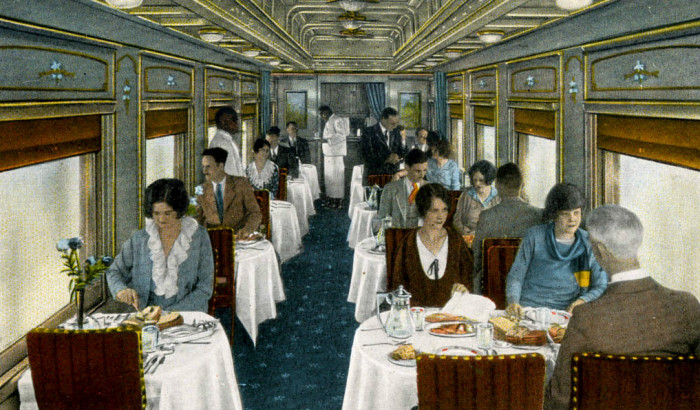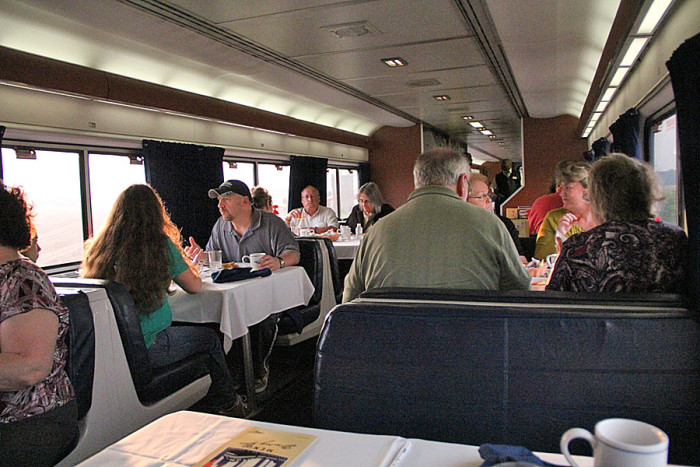It Starts in the Diner. Or Ends There.
After five or six years with this blog, it’s abundantly clear that, when it comes to train travel, food service is of the most interest to the most readers. I’m really not surprised. The dining car experience is what passengers remember most about their train trips. That’s been true since Day One.

Back in the Golden Age of train travel, the railroads found that promoting really excellent food service was the best way to compete for business. The Great Northern bragged that the Empire Builder dining cars served rainbow trout that were caught just hours before and handed aboard the train in Montana. Who knows? Maybe the hand-off was at Essex by the Izaak Walton Inn.
Yes, of course extra touches like that were expensive, but the railroads were more than willing to lose money on food service because passengers told all their friends and family about a really good dining car experience. All that positive talk attracted more passengers, and more passengers meant more revenue. Everyone understands the value of really good word-of-mouth advertising. Well, except members of Congress.

Unfortunately, bending under constant criticism from The Hill, outgoing CEO Joe Boardman promised that Amtrak will break even on its food service within five years. The trouble is, they’re trying to do that by cutting costs and, as an inevitable result, the dining car experience on Amtrak just ain’t what it used to be.
Not so long ago, Amtrak chefs were sent to culinary school and then had the latitude to add some of their own specialties to the menu. No more. The regional dishes are gone and today every dining car on every long-distance train offers exactly the same menu. Worse, there are fewer items from which to choose.
A year ago, if you wanted a dessert, you could get a generous wedge-shaped piece of cheesecake that was served on a plate with some strawberry sauce on top; today the cheesecake comes in a round plastic bowl and it’s pink. You can still get Häagan-Dazs ice cream, but only vanilla, and it’s about half the size of last year’s serving.
Republicans in Congress either don’t understand or won’t admit that you can’t achieve break-even by cutting costs if the cost-cutting results in a decrease in revenue. And so far there is ample albeit anecdotal evidence that the deterioration of the dining car experience isn’t making new friends for Amtrak.
It is, in sum, exactly the wrong approach to the problem. By trying to satisfy the anti-subsidy ideologues in Congress—and good luck with that!— Amtrak has noticeably diminished the dining experience, thus disappointing passengers who may now be less inclined to take other long-distance trains in the future.




As the extreme downgrading of the dining cars epitomizes the corporate funk at Amtrak HQ, we can only embrace what Pogo once said: “We have met the enemy and it is us!” A new management team is required to advocate for the customer experience by not being intimidated by Congress, or, timid with DOT.
What Amtrak needs going forward is an integrated management TEAM not making decisions in isolation that impact what other sectors are attempting to achieve. For example, where has Marketing been not to push back on Finance over these pathetic cuts in food & beverage services that encroach upon and destroy the overall Amtrak brand itself? It’s bad enough the customer has to put up with longer schedules than 1971, or ridiculous arrival times at end points, like the “Sunset Limited” into LA, but where is the experience to acknowledge that this could be more acceptable given an improved dining/lounge experience?
Amtrak is either “at the bumper post or the mile post.” When will somebody stand up to a schism of Congress that does not even realize (or care?) that Amtrak is building 25-30 new diners at the same time it is mutating, if not killing, the concept itself?
Sadly, who knew when Amtrak modernized the galley and eliminated the presto logs, that the passenger experience would be taking such a dramatic step backwards re menu selection, quality of food-purchased, cooked, and served, holiday meals, cocktails, etc? At the same time, how was is it that the American European Express, American Orient Express, VIA Rail, and Rocky Mountaineer figured the art and satisfaction of dining correctly? (Note- the AEE and AOE succumbed to severe financial issues unrelated to dining).